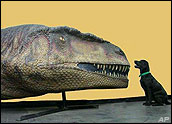
Meet Mapusaurus roseae, the largest carnivore on Earth recorded to date. Paleontologists working in the Patagonian wilderness in Argentina who found the remains of the 41-foot long and 15,000-pound dinosaur species said it roamed Earth 100 million years ago and was far bigger than Tyrannosaurus rex.
“This is the fourth species of carnivorous dinosaur in the five ton or greater size range,” said Thomas R. Holtz, Jr., Ph.D., senior lecturer with the department of geology at the University of Maryland.
Mapusaurus roseae joins the family of giant meat eaters that includes Giganotosaurus and Carcharodontosaurus, said Rodolfo Coria, Ph.D, paleontologist with the Carmen Funes Museum in Plaza Huincul, Argentina.
Coria and excavation co-leader Philip J. Currie of the University of Alberta in Edmonton named the newest find. “Mapusaurus” means “Earth” in the Mapuche Indians’ tribal language. “Roseae” is a tribute to Rose Letwin, who contributed funding for the research.
Coria and Currie found the 100 million-year-old Mapusaurus fossils in the same region where Giganotosaurus and Argentinosaurus, two species also co-named by Coria, were discovered.
Hunted in Packs?
Coria described the Mapusaurus as about the same size as Giganotosaurus, although more slender. Argentinosaurus is the largest dinosaur known to exist. The 125-foot-long plant eater is four times the size of Mapusaurus and weighs in at 100 tons.
In spite of being smaller, Mapusaurus may have been able to kill the largest dinosaur. The meat eater may have hunted in packs, and the Argentinosaurus probably was slower. If Mapusaurus did work in groups, how they attacked their prey remains unknown. Some predators are known to cooperate during a hunt, while others gather to feed after a single individual makes the kill.
“The site where we found Mapusaurus is formed by a burial of several individuals of different sizes and ages. This probably indicates they lived in packs,” Coria told TechNewsWorld.
This discovery marks the first time scientists have seen evidence of meat-eating dinosaurs living in groups. The researchers unearthed the remains of at least seven animals ranging from a youngster 18 feet long to an adult at 40 feet long. They also discovered a 100-ton sandstone deposit with hundreds of fossils.
Since researchers found no signs of disease in the fossils, they believe the dinosaurs perished in a mass catastrophe.
Upper Size Limit Likely
Though the researchers discovered the bones a few years ago, this is the first time they’ve announced the results of their study and the significance of the finding, Coria noted.
“Currie and Coria took care to be careful and thorough in their research, and then it took time for the study to make its way through the publication pipeline,” Holtz explained.
The researchers believe there are more dinosaur specimens waiting to be discovered at the site. “Dinosaur diversity … was way more complex than we know today,” said Coria. “Also, we’re just starting to analyze several aspects connected to physiological mechanisms — growing rate, energy balance, body temperature control,” he added. Scientists are working on the development of new technologies to carry out these analyses.
“This study shows that each of the three groups — tyrannosaurs, carcharodontosaurs and spinosaurs — that produced super-giant predatory dinosaurs all peak out at around the same body size,” Holtz pointed out. “It suggests that they were reaching the limits of body size for being a predator in the world of dinosaurs.”




















































